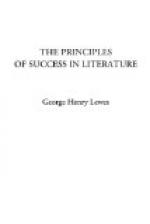felt in the English landscape, because its images may
more forcibly arrest his attentlon by their novelty.
And were this not so, were the inalienable impressiveness
of tropical scenery always to give the poet who described
it a superiority in effect, this would not prove the
superiority of his imagination. For either he
has been familiar with such scenes, and imagines them
just as the other poet imagines his English landscape—–by
an effort of mental vision, calling up the absent
objects; or he has merely read the descriptions of
others, and from these makes up his picture. It
is the same with his rival, who also recalls and recombines.
Foolish critics often betray their ignorance by saying
that a painter or a writer “only copies what
he has seen, or puts down what he has known.”
They forget that no man imagines what he has not seen
or known, and that it is in the selection of
the characteristic details that the
artistic power is manifested. Those who suppose
that familiarity with scenes or characters enables
a painter or a novelist to “copy” them
with artistic effect, forget the well-known fact that
the vast majority of men are painfully incompetent
to avail themselves of this familiarity, and cannot
form vivid pictures even to themselves of scenes in
which they pass their daily lives; and if they could
imagine these, they would need the delicate selective
instinct to guide them in the admission and omission
of details, as well as in the grouping of the images.
Let any one try to “copy” the wife or
brother he knows so well,—to make a human
image which shall speak and act so as to impress strangers
with a belief in its truth,—and he will
then see that the much-despised reliance on actual
experience is not the mechanical procedure it is believed
to be. When Scott drew Saladin and Ceaur de Lion
he did not really display more imaginative power than
when he drew the Mucklebackits, although the majority
of readers would suppose that the one demanded a great
effort of imagination, whereas the other formed part
of his familiar experiences of Scottish life.
The mistake here lies in confounding the sources from
which the materials were derived with the plastic power
of forming these materials into images. More
conscious effort may have been devoted to the collection
of the materials in the one case than in the other,
but that this has nothing to do with the imaginative
power employed may readily be proved by an analysis
of the intellectual processes of composition.
Scott had often been in fishermen’s cottages
and heard them talk; from the registered experience
of a thousand details relating to the life of the
poor, their feelings and their thoughts, he gained
that material upon which his imagination could work;
in the case of Saladin and Ceaur de Lion he had to
gain these principally through books and his general
experience of life; and the images he formed—the
vision he had of Mucklebackit and Saladin—must
be set down to his artistic faculty, not to his experience
or erudition.




